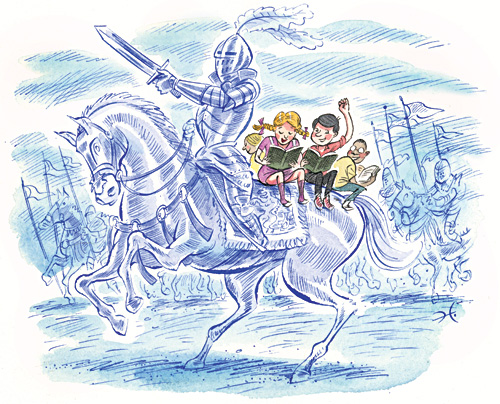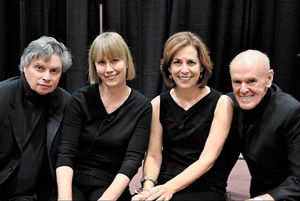2018 School Spending Survey Report
Have You Heard the Word? For a low-budget way to get kids wild about reading, try readers theater.

Illustration by Gary Hovland
What happens when you combine the thrill of theater with the magic of books? You get readers theater.
Where do you turn to use literature in a lively way that enhances young people’s reading pleasure and writing skills? You turn to readers theater. What do you do when you have little or no money, but need to create a book program that takes advantage of “out loud culture” (kids’ book expert Michael Cart’s smart phrase)? You go to readers theater. Who can perform readers theater? Anyone who can read. In fact, it also works well when young people and adults perform together. In its simplest sense, readers theater is the presentation of written work in a dramatic format. The fundamental difference between readers theater and traditional theater is that performers read their lines. With readers theater there’s no memorization, and usually there are no sets or costumes. There’s also little or no stage movement. It’s mostly performed in a room—not a theater—with scripts resting on music stands. The cost is almost nothing. What are the rewards? Enormous. Kids and adults love to engage in readers theater either as performers or as members of the audience. Rehearsal time can be minimal or maximized, depending on the level of polish you seek. The format has little of the tension, stress, or problems associated with the memorization of texts or other elements of staged productions. Young people are more than capable of creating such a presentation. They can be involved in selecting the text, creating the script, and choosing the roles. Readers theater engages readers and audiences with books in an exciting and entertaining way that encourages reading. There’s nothing, I think, that has been written that can’t be reshaped as readers theater: poetry, picture books, nonfiction, novels, and short stories. I’ve even heard newspaper stories performed this way. A given work can be adapted so that it has a cast of one, twenty, or more. Beyond all else, readers theater places literature at the very center of a shared experience. It’s a very old form of entertainment. Most likely Homer’s Iliad was meant to be recited out loud. (Plato, the Greek philosopher, would complain that writing diluted the reading skills used in performances.) Beowulf was probably intended to be read to audiences. There is a 14th-century illustration of Chaucer (he of The Canterbury Tales) doing a reading at King Richard the Second’s court. It has been claimed that Charles Dickens became the first modern celebrity by virtue of his highly dramatic public readings of his own novels. Stop and think and you’ll realize that readers theater was once the principal form of mass entertainment in the United States. We called it radio. Effective? Back in 1938, Orson Wells’s Mercury Theatre did a readers theater performance of H. G. Wells’s The War of the Worlds, which panicked a large portion of the population. Audiobooks may be thought of as a form of readers theater. Listen to the recordings from Bruce Coville’s Full Cast Audio, a company that offers unabridged recordings of children’s books as readers theater. Play the CDs for your students and they’ll get the idea, pronto. My own connection with readers theater began when my mother read to me and my siblings when we were children in the 1940s in New York City. (A good reading is, I submit, a dramatic reading—in the same fashion as is an effective booktalk.) I was a passionate listener of radio drama—particularly kids’ serials, such as Superman, The Lone Ranger, and Jack Armstrong. I adored them so much that later on I would write the novel Who Was That Masked Man, Anyway? (Scholastic, 1992), which seeks to capture the impact of the radio on kids. You might say it’s readers theater as a novel! I also have a fond memory of Charles Laughton performing a George Bernard Shaw play on a Broadway stage in a readers theater performance. My own interest in Dickens once led me to the Morgan Library in New York City. There, I saw an exhibit of his manuscripts, which included the texts for his reading performances. What I discovered was that Dickens changed his novels so as to make them more effective for readers theater. Dickens cut, compressed, and sometimes rearranged his text, and now and again, he even rewrote it—all to heighten the dramatic impact. His readings from Oliver Twist were said to be extraordinary, mesmerizing. The way Dickens worked with his books proved to be a revelation for me. It taught me that Dickens understood that readers theater is a distinct literary form—not quite theater (in which he was also engaged), not quite novel writing (from which he derived his fame). All of this is to suggest that when performing readers theater one need not, indeed, one should not, perform texts with word-for-word exactitude. It is a unique form of public entertainment.
The Loud Crowd: from left, Avi, Sarah Weeks, Pam Muñoz Ryan, and Richard Peck, members of Authors Readers Theatre
All of these experiences led me to create Authors Readers Theatre (ART) in 2006 with fellow writers Sharon Creech, Walter Dean Myers, and Sarah Weeks. Functioning as a kind of repertory theater group with an evolving core of author-performers, we have been performing readers theater all over the country, including at last summer’s American Library Association conference in Chicago. Librarians and teachers often ask us about the issue of copyright: Can I use a text without permission from the publisher or author? A class or school project that stays within the library or school, for which no admission is charged, is free of problems. That said, if you do plan to charge admission or use copyrighted texts to raise funds, permission may need to be secured. In our performances, ART offers an hourlong program of high drama and slapstick farce, from the moving narrative of Pam Muñoz Ryan’s Esperanza Rising (Scholastic, 2000) to Sarah Weeks’s hilarious picture book Woof: A Love Story (HarperCollins, 2009). Costumes? When ART performs, we always dress in black to create a simple unified effect. (You can find out more about us at www.authorsreaderstheatre.com.) More suggestions? Readers theater texts are easy enough to acquire or create. A good place to look is TeachingBooks.net, which offers more than 200 readers theater scripts. The number (and age and experience) of your performers will also shape your text selection and what you do with it. If you’re creating your own script, start off by removing the “he saids” and “she saids” from the original text. Cut back descriptive passages to their dramatic essence. If necessary, add text that allows the audience to more fully grasp what’s happening. Don’t be afraid of blending text from different parts of the story if it effectively tells the tale. Break up longer sections among many voices for maximum dramatic effect. While it helps to be gender specific, it’s not necessary. That said, it’s best if one performer remains consistent with one voice or character. Learn (with your performers) to adjust, trim, and add during rehearsal. Keep in mind that with readers theater it’s best to use works that lend themselves to intense dramatic effects. Dickens’s most famous reading performance was the murder of Nancy from Oliver Twist. You’ll also want to use something that is essentially self-contained—rather like a short story—or an excerpt from a longer work that leads to a dramatic climax. The more dialogue there is, the easier the script making will be. But powerful expository writing can also be very effective if it’s arranged for a multivoiced (and even choral) presentation. At the heart of readers theater is voice. I won’t belabor the obvious value of learning how to speak forcibly, clearly, and with understanding that readers theater can bring. But performers gain much more from readers theater. When young people begin to get into the voice of a gifted writer, they begin to internalize that voice, be it its vocabulary, rhythm, or structure. That internalization will enhance not only their own speech, but also their writing. I believe my own writing has been heavily influenced by my radio-listening years. These days, I can be writing away, when suddenly the tonalities, or the literary voice of one of my ART colleagues, say Richard Peck, pops into my head and I find myself shaping my own phrasing with some of his spot-on wit. (Thank you, Richard!) You can imagine how powerful this can be for young writers. While voice alone can, and will, carry the show, there is no reason not to introduce audiovisual effects. Projecting book jackets via PowerPoint is both easy and effective. When ART performs Brian Selznick’s The Invention of Hugo Cabret (Scholastic, 2007), we project images from the book, which enhance the performance and capture the unique integration of Brian’s art and text. In the same sequence, ART performers add vocal sound effects. On occasion, when performing solo, I’ve also used music. All of this low-level technology requires more rehearsal, more effort, but it can be well worth it—it heightens the theatricality, and takes nothing away from the voices. So consider a group of eighth graders—let’s call them “The Picture Book Players”—doing readers theater for first graders with PowerPoint images projected on a screen. Imagine a bunch of middle school kids performing the Orson Wells readers theater version of The War of the Worlds at a school assembly! (You can find the script at www.janaedwards.com/WarWorlds.html.) Or turn your book club into a readers theater ensemble that performs at kids’ hospitals or parents’ night at school or… wherever. Have voices, will travel. In sum, readers theater is a highly effective means of bringing young readers into intense involvement with literature. The key to it all is to embrace poet Robert Frost’s notion: “The ear is the best reader.”Avi’s most recent books are Murder at Midnight (Scholastic, 2009) and Poppy and Ereth (HarperCollins, 2009). You can visit him at www.Avi-writer.com.
RELATED
RECOMMENDED
CAREERS
The job outlook in 2030: Librarians will be in demand
CAREERS
The job outlook in 2030: Librarians will be in demand
ALREADY A SUBSCRIBER? LOG IN
We are currently offering this content for free. Sign up now to activate your personal profile, where you can save articles for future viewing






Add Comment :-
Be the first reader to comment.
Comment Policy:
Comment should not be empty !!!